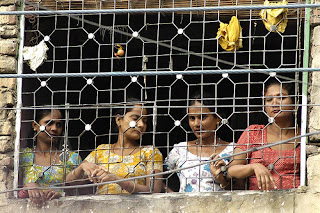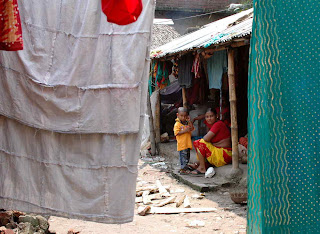Tuesday, July 19, 2011
Friday, July 15, 2011
In America, children are still for sale
In America, children are still for sale...
An estimated 600,000 children are prostituted or exploited in and through pornography - (USDOJ / HHS)
An estimated 2.8 million children live on the streets - (National Runaway Switchboard)
Up to 95% of all prostitutes were sexually abused as children - (Genesis House)
Every year a prostituted girl is raped 19 times, kidnapped 10 times and beaten repeatedly - (WHISPER National Task Force on Prostitution)
Child prostitution is widespread and a serious problem.
Child prostitution
Child prostitution is widespread and a serious problem. The majority of Bangladeshi prostituted children are based in brothels, with a smaller number of children exploited in hotel rooms, parks, railway and bus stations and rented flats.
The UN Children's Fund (UNICEF) estimated in 2004 that there were 10,000 underage girls used in commercial sexual exploitation in the country, but other estimates placed the figure as high as 29,000.[1]
Many girls involved in child labour, such as working in factories and as domestic workers are raped or sexually exploited, these girls are highly stigmatised and many of them flee to escape such abuse, but often they find that prostitution is the only option open to them for survival—once in prostitution they become even more marginalized.[4]
More than 20,000 children are born and live in the 18 registered red-light areas of Bangladesh. Boys tend to become pimps once they grow up and girls continue in their mothers’ profession. Most of these girls enter the profession before the age of 12.[5][6]
Disabled children who live in institutions and children displaced as a result of natural disasters such as floods are highly susceptible to commercial sexual exploitation.[4]
The authorities generally ignore the minimum age of 18, often circumvented by false statements of age, for legal female prostitution; the government rarely prosecutes procurers of minors.[1]
Violence against prostitutes
While laws relating to violence against women, including rape, apply equally to prostitutes, in practice they are discriminated against as they will be classified as 'habituated' to sexual intercourse and proof will be considered to be harder to give/accept. Prostitutes are often subjected to harassment and violence from the Police who are theoretically supposed to protect their rights.
Monday, July 11, 2011
İstanbul’un, “Kentsel Dönüşüm Projesi” adı altında değiştirilmesi planlanan bölgelerinden biri olan Perşembe Pazarı’nı burada çalışan esnafın üzerinden anlatmaya çalıştım. Cenevizlilerden bu yana ulaşım imkanlarının kolaylığı nedeniyle ticaretin merkezi olan Perşembe Pazarı, 1950 ve 1980’li yıllarda uğradığı yıkımlarla bir harabeye dönüştürüldü. Esnafın çoğu Perpa adındaki alışveriş merkezine göç ettirildi. Kalanlar ise çıkartılacakları günü kaygıyla bekliyor.
Kamu kaynaklarının varsıllara rant yaratmak yerine ihtiyacı olanların hayatlarını iyileştirmek için kullanılması gerektiğine inanıyorum. Bu, aynı zamanda egemen güçlerin dünyanın sahibi olmadıklarını göstermekle iligili bir tavır. Yenileme adına, yaşanılan bir bölgenin ruhsuz ve yapmacık bir hale getirilmesini istemiyorum. Bir semtin yüzlerce yıllık kültürü birdenbire yok edilemez.
Niyetim, insanların yaşam alanlarının baskıcı bir tavırla ellerinden alınmasına karşı çıkmak ve steril, turistik ‘disneyland’lar yaratılmasının önünde durmak. Bir fotomuhabiri olarak bu durumda kaybedeceğimiz değerlerin neler olduğunu anlatabilmek. Belgeselin asıl işlevi, bu kadar kısa zamanda haksızlık ve eşitsizliklerle dolu bu kadar hızlı bir değişimi belgelemek suretiyle bu haksızlığın önüne geçecek bir hareket yaratabilmektir.
Perşembe Pazarı is one of the places which are planned to be transformed through the urban transformation project of Istanbul and I tried to give a picture of its story via the craftsmen working in Perşembe Pazarı. Since the times of Genoese, it was the center of trade in Istanbul because of its access facilities. But it is ruined in 50’s and 80’s by the governments of the time. Most of the craftsmen were forced to move to the business center Perpa. And now the others are waiting for the day they will be removed.
I believe that public sources should be used for enhancing the lives of the ones who need it instead of providing the rich with unearned income. This is also an attitude of claiming that the dominant powers are not the owners of the world. I am opposed to the idea of transforming living quarters into some artificial and dull places. Because the unique cultural heritage of a neighborhood should not be destroyed all at once in such a way.
My aim is standing up to the ones who take people’s living spaces away from them in a domineering way and try to create some new touristic and sterile ‘Disneyland’s. As a photojournalist, I try to show what a loss for us it will be. So the main function of the documantary is to create a movement against this injustice by recording this huge and fast transformation as much as possible.
Fotoröportaj: Fatih Pınar
fatihpinar.com
Tuesday, July 5, 2011
Ralph Eugene Meatyard
(American, 1925-1972)
I work in several different groups of pictures which act on and with each other – ranging from several abstracted manners to a form for the surreal. I have been called a preacher – but in reality, I’m more generally philosophical. I have never made an abstracted photograph without content. An educated background of Zen influences all of my photographs.
— Ralph Eugene Meatyard, 1961
In his 1911 collection, The Devil’s Dictionary, American writer Ambrose Bierce defined ‘romance’ as “Fiction that owes no allegiance to the God of things as They Are.” Ralph Eugene Meatyard, a great reader who was known to find inspiration in literature and philosophy more often than in visual media, makes reference to the passage in his 1964 photograph “Romance (N.) From Ambrose Bierce #3.” While Meatyard worked on a variety of projects, from the No Focus pictures to the Zen Twig series, several features of “Romance (N.) From Ambrose Bierce #3” are characteristic of his work. Meatyard often used friends and family, particularly his children, as models in his carefully directed photographs. Likewise, the use of props was not uncommon (doll parts, dead birds, and dime-store masks were particular favorites); it is worth noting that the mask worn by the child at the bottom of the bleacher steps would later be the face of the central figure in 1969-1972’s Lucybelle Crater series. As with all of Meatyard’s pictures, this one was surely photographed in or around northern Kentucky. More importantly, though, it plays with deliberate ambiguity and paradox, much the way a Zen riddle is constructed to promote contemplation.
At a time when photographs tended to document the world unadorned, the expressive quality of Meatyard’s pictures was generally out of favor with the artistic community of the 1950s. It was basically not until the 1970s that his work came to any notable prominence. Though he assigned himself the title “amateur” (and wore it proudly), he was long disappointed that his contributions to photography were not more widely recognized. In response to his omission from the 1964 edition of Beamont Newhall’s seminal History of Photography, Meatyard mounted a print of “Romance (N.) From Ambrose Bierce #3” as the frontispiece in his own copy.
Ralph Eugene Meatyard was born in Normal, Illinois on May 15, 1925. He served in the Navy, studied pre-dentistry at Williams College (1943-44) and philosophy at Illinois Wesleyan University (1950). He began his career as an optician in 1949. The optical firm where he worked, Tinder-Krauss-Tinder, also sold photographic equipment and supplies. There Meatyard purchased his first camera in 1950 in order to photograph his newborn son. Once established in his own practice, Eyeglasses of Kentucky, he hung the walls of the reception area with rotating exhibitions of his own pictures and those of other photographers, including Emmet Gowin. Meatyard exhibited selections from Georgetown Street, a collaborative effort with Van Deren Coke, along with other early work at Roy DeCarava’s A Photographer’s Place in 1957-8, and had his first solo show in 1959 at Tulane University. Throughout his career as photographer, he continued working as an optometrist at Eyeglasses of Kentucky, and was known to his friends as a devoted family man who somehow eked out time to photograph on weekends. Meatyard’s interest in Eastern thinking was sparked at a workshop in Indiana where Minor White recommended a list of books crucial to a photographer’s education which included two volumes on Zen. Photographs by Meatyard are in the collections of the Metropolitan Museum of Art and Museum of Modern Art in New York; George Eastman House International Museum of Photography and Film, Rochester, New York; Center for Creative Photography, University of Arizona, Tucson; Massachusetts Institute of Technology, Cambridge; Smithsonian Institution, Washington, D.C.; and University of Louisville Photographic Archives, Kentucky. He died of cancer in Lexington, Kentucky on May 7, 1972.
Subscribe to:
Comments (Atom)


















































